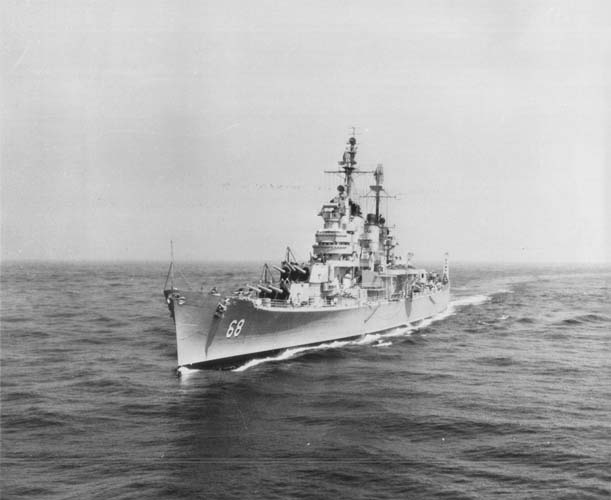Navy Vessels on Duty at Fermilab
It is an old seafaring tradition that on a night when the moon is dim and the mists rise off the sea, if you listen carefully and look sharp, you may hear the tolling of a ship's bell and see a ghostly vessel sailing above the spot where a sunken ship lies. And you may see the spectral form of the Captain restlessly pacing an ephemeral quarter deck. If the old tradition holds, an experimenter working the owl shift in the experimental lines at Fermilab may, through the prairie fogs, see phantom ships of the U.S. Navy line - Wasp, Philippine Sea, or Baltimore, just to name a few. The valuable metals once built into tools of war now serve the future of the world in peaceful basic research at Fermilab. The swords of the Navy's battle fleet have become the plowshares of nuclear research.
The very large number of protons accelerated to unprecedented energies in the Fermilab accelerator system produce, besides the particles desired for a particular experiment, large numbers of other background particles which obscure the effects to be observed in experiments. To filter out these unwanted particles, large quantities of high density material are required between the point where the protons from the accelerator strike their target and the delicate experimental apparatus.
Several things were considered to achieve the separation of extraneous from essential particles: a graveyard of used automobiles, slag ore from steel mills, soil mounds. Soil is used extensively in the mounds in the Meson and Neutrino experimental areas. Steel, though, is often much better. Casting about for an inexpensive source of the huge quantities of steel needed at the Laboratory, a cooperative arrangement was developed with the U.S. Navy to acquire the heavy armor plate from retired fighting ships and the lead ballast from submarines when such ships are dismantled. The armor plate of some 18 Navy ships - ten heavy cruisers, five aircraft carriers and three submarines - now serves the experimental areas at Fermilab.
The Laboratory is notified by the Energy Research and Development Administration (ERDA) when ships are declared surplus by the Navy. Armor that could be useful to Fermilab is requisitioned by the Fermilab Research Division and ERDA then requests that this steel be reserved for the Laboratory's needs.
The hull of a naval vessel contains sheets of armor plate, typically 8' x 10' and 3 1/2 to 6" thick, weighing at least four tons each. (Much research in the manufacture of steel has been instigated by the navies of the world in the 115 years since the change from wooden to armored ship hulls.) The armor plates are delivered to Fermilab by either rail or truck.
Trenches are excavated on the beam line, and the plates are then laid flat, by special riggers, in piles surrounding the beam pipes on the Proton Line. The number and dimensions of the plates are carefully recorded so that effectiveness of the shielding can be calculated.
The Laboratory has received about 3,000 tons of such armor plate thus far. Another 2,000 tons is on order. A cruiser typically yields 200 tons, an aircraft carrier, 600 tons. Shipments are made in lots large enough to be economical. Transportation of the steel costs $53 a ton, limiting the amount the Laboratory can reasonably procure each fiscal year. Fermilab would potentially utilize as much as 100,000 tons if accelerator energy were increased to 1,000 BeV.
The vessels now at rest at Fermilab played important roles in U.S. history. The cruiser Baltimore, for example, served a major role in the Pacific theater in the early part of World War II. In July, 1944, Baltimore carried President Roosevelt to a meeting with Admiral Nimitz and General McArthur at Pearl Harbor. In peaceful times, Baltimore represented the U.S. Navy in the Coronation Naval Review in Spithead, England in 1953. The ship was decommissioned in May, 1956; her armor plate arrived for use at Fermilab in April, 1973.
Two other ships of the "Baltimore class" - Fall River and Macon - have also come to Fermilab. Fall River arrived in August, 1974, and 376 long tons of its steel were promptly lowered into the Fermilab P-E line. Fall River was in the Marshall Islands in 1946 as flagship for the "Operations Crossroads" atomic weapons tests. The ship was placed out of commission in October, 1947, in the Puget Sound Navy Yard. Macon accommodated many training cruises for midshipmen, as well as launching the first test of a Regulus Missile. Macon's crew is also credited with saving the lives of merchantmen when their vessel burned, in the Atlantic in 1959. One Naval historian notes, "There can be little doubt that at the time of their completion, the 'Baltimore class' were the finest example of their class for ocean warfare, and no vessels short of capital rank could contain them."
Five former aircraft carriers of the "Essex class" now belong to the Fermilab "fleet": U.S.S. Antietam, Bunker Hill, Lake Champlain, Philippine Sea and Princeton. Antietam was the first aircraft carrier to be fitted with a revolutionary angled deck for aircraft operation. The USS Antietam CV-36 aircraft carrier was also active in the Korean War, with two battle stars. Bunker Hill and Princeton were active in World War II Pacific theater action. Lake Champlain served in the Korean War, as did Philippine Sea. These ships carried a war-time complement in excess of 3,500 officers and men.
Fermilab experimental lines now also contain parts of two light cruisers of the "Worcester class" - Worcester and Roanoke. The two ships were known for their keen defense against air attack coupled with potential for heavy volume of fire power in surface action.
Buried deep in the Fermilab particle research facilities, the massive remains of the ships in a sense still carry on the Naval tradition by participating in another important phase of American history.









